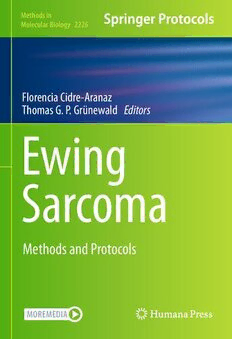
Ewing Sarcoma: Methods and Protocols PDF
Preview Ewing Sarcoma: Methods and Protocols
Methods in Molecular Biology 2226 Florencia Cidre-Aranaz Thomas G. P. Grünewald Editors Ewing Sarcoma Methods and Protocols M M B ETHODS IN OLECULAR IO LO GY SeriesEditor JohnM.Walker School of Lifeand MedicalSciences University ofHertfordshire Hatfield, Hertfordshire, UK Forfurther volumes: http://www.springer.com/series/7651 For over 35 years, biological scientists have come to rely on the research protocols and methodologiesinthecriticallyacclaimedMethodsinMolecularBiologyseries.Theserieswas thefirsttointroducethestep-by-stepprotocolsapproachthathasbecomethestandardinall biomedicalprotocolpublishing.Eachprotocolisprovidedinreadily-reproduciblestep-by- step fashion, opening with an introductory overview, a list of the materials and reagents neededtocompletetheexperiment,andfollowedbyadetailedprocedurethatissupported with a helpful notes section offering tips and tricks of the trade as well as troubleshooting advice. These hallmark features were introduced by series editor Dr. John Walker and constitutethekeyingredientineachandeveryvolumeoftheMethodsinMolecularBiology series. Tested and trusted, comprehensive and reliable, all protocols from the series are indexedinPubMed. Ewing Sarcoma Methods and Protocols Edited by Florencia Cidre-Aranaz and Thomas G. P. Grünewald Division of Translational Pediatric Sarcoma Research, German Cancer Research Center (DKFZ) Hopp-Children’s Cancer Center (KiTZ), Heidelberg, Germany Editors FlorenciaCidre-Aranaz ThomasG.P.Gru¨newald DivisionofTranslationalPediatric DivisionofTranslationalPediatricSarcomaResearch SarcomaResearch GermanCancerResearchCenter(DKFZ) GermanCancerResearchCenter(DKFZ) Hopp-Children’sCancerCenter(KiTZ) Hopp-Children’sCancerCenter(KiTZ) Heidelberg,Germany Heidelberg,Germany ISSN1064-3745 ISSN1940-6029 (electronic) MethodsinMolecularBiology ISBN978-1-0716-1019-0 ISBN978-1-0716-1020-6 (eBook) https://doi.org/10.1007/978-1-0716-1020-6 ©SpringerScience+BusinessMedia,LLC,partofSpringerNature2021 Thisworkissubjecttocopyright.AllrightsarereservedbythePublisher,whetherthewholeorpartofthematerialis concerned,specificallytherightsoftranslation,reprinting,reuseofillustrations,recitation,broadcasting,reproduction onmicrofilmsorinanyotherphysicalway,andtransmissionorinformationstorageandretrieval,electronicadaptation, computersoftware,orbysimilarordissimilarmethodologynowknownorhereafterdeveloped. Theuseofgeneraldescriptivenames,registerednames,trademarks,servicemarks,etc.inthispublicationdoesnotimply, evenintheabsenceofaspecificstatement,thatsuchnamesareexemptfromtherelevantprotectivelawsandregulations andthereforefreeforgeneraluse. Thepublisher,theauthors,andtheeditorsaresafetoassumethattheadviceandinformationinthisbookarebelievedto betrueandaccurateatthedateofpublication.Neitherthepublishernortheauthorsortheeditorsgiveawarranty, expressedorimplied,withrespecttothematerialcontainedhereinorforanyerrorsoromissionsthatmayhavebeen made.Thepublisherremainsneutralwithregardtojurisdictionalclaimsinpublishedmapsandinstitutionalaffiliations. ThisHumanaimprintispublishedbytheregisteredcompanySpringerScience+BusinessMedia,LLC,partofSpringer Nature. Theregisteredcompanyaddressis:1NewYorkPlaza,NewYork,NY10004,U.S.A. Preface Ewing sarcoma is a highly aggressive bone and soft tissue tumor, which mainly affects children, adolescents, and young adults. It is a clinically complex disease, as despite treat- ment by local resection and systemic chemotherapy, patients presenting with metastasis at diagnosis or relapse have still a dismal prognosis. Paradoxically, Ewing sarcoma is a geneti- callyrelativelysimplecancer,characterizedbyapathognomonicfusiongene(EWSR1-ETS) that, once established, completely rewires the epigenetic and transcriptional signatures of the tumors’ cell(s)-of-origin. Although great advances have been achieved in the past decades, the exact mechanisms underlying Ewing sarcoma tumorigenesis and progression arestilllargelyunknown. OneofthemostchallengingaspectsofEwingsarcomaresearchandclinicalassessment is the scarcity of well-curated, highly standardized, and optimally working methods. Thus, thisvolumeofMethodsinMolecularBiology™aimsatcomprisingaselectionofthemost effectiveandwidelyemployedprotocolsintheEwingsarcomafield. Inordertoaccommodateawidevarietyofinvitro,invivo,andinsilicotechniquesthat maybeappliedtotheanalysisofEwingsarcoma,thisvolumeoftheMethodsinMolecular Biology™seriesisorganizedintofivesections:SectionIdealswithaselectionofmolecular biologytechniquesthathaveproventobeveryhelpfulwhenanalyzingEwingsarcoma.This sectionstartswithanintroductorychapterexplainingthekeyquestionofsomaticalteration and genetic predisposition, which may aid to stratify patients according to risk in Ewing sarcoma.Additionally,thissectiondescribesEwingsarcoma-specificprotocolsformolecular techniquesincludingtissuepreservation,nucleicacidisolationfromformalin-fixedparaffin- embedded samples, which are usually the result of patient’s solid biopsies and Western blotting. This chapter is complemented with a final comprehensive chapter on liquid biopsies. In order to help Ewing sarcoma clinicians and physician-scientists navigate the intrica- cies of diagnosis, Section II comprises all techniques applied to the morpho-molecular diagnosticsinEwingsarcoma,includingachapteronroutineimmune-histologicalanalysis which additionally describes all pre- and post-diagnostic procedures and three subsequent chapters on every molecular aspect that can be part of Ewing sarcoma diagnosis or confir- mation (fluorescence in situ hybridization (FISH), RT-PCR, and targeted RNA sequencing). Section III of this volume describes a collection of in vitro tools and cell culture functional assays to guide researchers on essential wet-lab techniques from Ewing sarcoma-specific re-expression models, to luciferase assays adapted to the analysis of regu- latory sequences present in Ewing sarcoma, to a set of functional assays implemented to evaluate the potential effect of re-expression or downregulation of particular genes or pathwaysand/ordeterminetheeffectivenessofselecteddrugs. Despite constant efforts since its first description in 1921, Ewing sarcoma remains a tumor entity of unclear cell of origin, which has underlined the importance of developing diverse methodsthat could recapitulatethe diseasein vivo. SectionIV presentssix chapters addressing these important animal models, starting with a method for a genetically engi- neeredmousemodelandcoveringothermodelssuchasclassicalsubcutaneousxenografting and orthotopic implants. Due to the increasing need for systems that could better v vi Preface recapitulate the complexity of patient´s tumors, we have included in this Section IV a dedicated chapter on patient-derived xenografts (PDX) and orthotopic xenografts for metastasis assessment in Ewing sarcoma. In addition to these mouse models, a protocol fordevelopingazebrafishmodelisalsodetailed. Asaresultofconstantdevelopmentofnewprojects,Ewingsarcomaresearcherscreatea staggering increase of highly valuable data. However, these data usually require being properly bioinformatically analyzed in order to obtain its maximum profitability. Thus, Section V of this volume contains four bioinformatic-focused chapters that range from a thorough compilation and description of repositories and databases essential for Ewing sarcoma research to a detailed explanation on how to address ChIP-seq, epigenetic, and systemsbiologyanalysesbyusingbothownoralreadypublisheddata. Collectively, this volume of Methods in Molecular Biology™ will be of interest to molecular biologists and physician-scientists working in the field of Ewing sarcoma or in pediatric fusion-driven tumors, physicians interested in diagnostic aspects, as well as to bioinformaticiansapproachingtheanalysisofEwingsarcoma. Ithasbeenourgreatpleasuretohavecollaboratedinthisvolumewithsomanytalented authors that are leaders in their respective fields. We are immensely thankful for their dedication to producing comprehensive chapters filled with extensively detailed tricks perfectedattheirlaboratories,whichwilldefinitelyhelpguideboththeadvancedandnovice researchers. It is our hope that this volume comprising a collective technical knowledge around Ewingsarcomawillbringusonestepforwardinthequesttofightthisdevastatingdisease. Heidelberg,Germany FlorenciaCidre-Aranaz ThomasG.P.Gru¨newald Contents Preface ..................................................................... v Contributors................................................................. ix PART I MOLECULAR BIOLOGY TECHNIQUES APPLIED TO EWING SARCOMA 1 GermlineVariationandSomaticAlterationsinEwingSarcoma ............... 3 MitchellJ.MachielaandThomasG.P.Gru¨newald 2 WesternBlotAnalysisinEwingSarcoma................................... 15 ArunaMarchettoandLauraRomero-Pe´rez 3 TissuePreservationandFFPESamples:OptimizedNucleicAcids IsolationinEwingSarcoma .............................................. 27 LauraRomero-Pe´rezandThomasG.P.Gru¨newald 4 LiquidBiopsiesinEwingSarcoma ........................................ 39 ManuelaKrumbholzandMarkusMetzler PART II MORPHO-MOLECULAR DIAGNOSTICS IN EWING SARCOMA 5 (Immuno)histologicalAnalysisofEwingSarcoma........................... 49 DavidMarcilla,IsidroMachado,ThomasG.P.Gru¨newald,Antonio ´ Llombart-Bosch,andEnriquedeAlava 6 MolecularApproachestoDiagnosisinEwingSarcoma:Fluorescence InSituHybridization(FISH) ............................................ 65 MarcelTrautmannandWolfgangHartmann 7 MolecularApproachestoDiagnosisinEwingSarcoma:RT-PCR ............. 85 CarlosRodrı´guez-Martı´nandJavierAlonso 8 MolecularApproachestoDiagnosisinEwingSarcoma:Targeted RNASequencing ....................................................... 105 CarmenSalguero-ArandaandJuanDiaz-Martin PART III CELLULAR BIOLOGYAND CELL CULTURE TECHNIQUES 9 EwingSarcoma-Specific(Re)expressionModels ............................ 119 MaximilianM.L.KnottandFlorenciaCidre-Aranaz 10 AnalysisofRegulatoryDNASequencesbyDual-Luciferase ReporterAssaysinEwingSarcoma........................................ 139 TilmanL.B.H¨oltingandMaximilianM.L.Knott 11 ProliferationAssessmentbyTrypanBlueExclusioninEwingSarcoma ........ 151 CorneliusMaximilianFunkandJulianMusa 12 DrugScreeningbyResazurinColorimetryinEwingSarcoma................ 159 JulianMusaandFlorenciaCidre-Aranaz vii viii Contents 13 AnalysisofMigrationandInvasioninEwingSarcoma....................... 167 FlorenciaCidre-Aranaz PART IV ANIMAL MODELS IN EWING SARCOMA 14 GeneticallyEngineeredMouseModelinEwingSarcoma .................... 183 MiwaTanakaandTakuroNakamura 15 TumorGrowthAnalysisofEwingSarcomaCellLinesUsing SubcutaneousXenograftsinMice......................................... 191 FlorenciaCidre-AranazandShunyaOhmura 16 MetastasisAssessmentinEwingSarcomaUsingOrthotopicXenografts ....... 201 RoserL(cid:1)opez-AlemanyandOscarM.Tirado 17 OrthotopicImplantsinMice............................................. 215 ElizabethStewart 18 EwingSarcomaPDXModels............................................. 223 DidierSurdez,LorenaLanduzzi,KatiaScotlandi, andMariaCristinaManara 19 UsingZebrafishLarvaeasaXenotransplantationModeltoStudy EwingSarcoma......................................................... 243 SusanaPascoal,SarahGrissenberger,EvaScheuringer,RitaFior, MiguelGodinhoFerreira,andMartinDistel PART V BIOINFORMATIC APPROACHES TO EWING SARCOMA 20 MainRepositoriesandDatabasesUsedinEwingSarcomaResearch........... 259 MariaDebiec-Rychter 21 ChromatinImmunoprecipitationFollowedbyNext-Generation Sequencing(ChIP-Seq)AnalysisinEwingSarcoma......................... 265 GwennegKerdivelandValentinaBoeva 22 EpigeneticAnalysisinEwingSarcoma..................................... 285 JeremyM.SimonandNicholasC.Gomez 23 SystemsBiologyAnalysisforEwingSarcoma............................... 303 MarianyelaPetrizzelli,JaneMerlevede,andAndreiZinovyev Index ...................................................................... 335 Contributors JAVIERALONSO • UnidaddeTumoresS(cid:1)olidosInfantiles,InstitutodeInvestigaci(cid:1)onde EnfermedadesRaras,InstitutodeSaludCarlosIII,Madrid,Spain;Centrode Investigaci(cid:1)onBiome´dicaenReddeEnfermedadesRaras,InstitutodeSaludCarlosIII (CB06/07/1009;CIBERER-ISCIII),Madrid,Spain VALENTINABOEVA • INSERM,U1016,CochinInstitute,CNRSUMR8104,ParisDescartes University,Paris,France;DepartmentofComputerScience,ETHZurich,Institutefor MachineLearning,Zurich,Switzerland;SwissInstituteofBioinformatics(SIB),Zu¨rich, Switzerland FLORENCIACIDRE-ARANAZ • DivisionofTranslationalPediatricSarcomaResearch,German CancerResearchCenter(DKFZ),Heidelberg,Germany;HoppChildren’sCancerCenter (KiTZ),Heidelberg,Germany;GermanCancerConsortium(DKTK),PartnerSite Heidelberg,Heidelberg,Germany ´ ENRIQUEDE ALAVA • InstituteofBiomedicineofSevilla(IBiS),VirgendelRocioUniversity Hospital/CSIC/UniversityofSevilla/CIBERONC,Seville,Spain;DepartmentofNormal andPathologicalCytologyandHistology,SchoolofMedicine,UniversityofSeville,Seville, Spain MARIADEBIEC-RYCHTER • DepartmentofHumanGenetics,KULeuvenan,University HospitalLeuven,Leuven,Belgium JUANDIAZ-MARTIN • DepartmentofPathology,InstitutodeBiomedicinadeSevilla,CSIC- UniversidaddeSevilla,HospitalUniversitarioVirgendelRocı´o,Seville,Spain MARTINDISTEL • InnovativeCancerModels,St.AnnaChildren’sCancerResearchInstitute, Vienna,Austria MIGUELGODINHOFERREIRA • InstituteforResearchonCancerandAgingofNice (IRCAN),Universite´Coˆted’Azur,NiceCedex2,France RITAFIOR • ChampalimaudCentrefortheUnknown,ChampalimaudFoundation,Lisbon, Portugal CORNELIUS MAXIMILIANFUNK • DivisionofTranslationalPediatricSarcomaResearch, GermanCancerResearchCenter(DKFZ),Heidelberg,Germany;HoppChildren’sCancer Center(KiTZ),Heidelberg,Germany NICHOLASC.GOMEZ • LaboratoryofMammalianCellBiologyandDevelopment,The RockefellerUniversity,NewYork,NY,USA SARAH GRISSENBERGER • InnovativeCancerModels,St.AnnaChildren’sCancerResearch Institute,Vienna,Austria THOMASG.P.GRU¨NEWALD • DivisionofTranslationalPediatricSarcomaResearch,German CancerResearchCenter(DKFZ),HoppChildren’sCancerCenter(KiTZ),Heidelberg, Germany WOLFGANGHARTMANN • DivisionofTranslationalPathology,Gerhard-Domagk-Instituteof Pathology,Mu¨nster,Germany TILMANL.B.HO¨LTING • Max-EderResearchGroupforPediatricSarcomaBiology,Faculty ofMedicine,InstituteofPathology,LMUMunich,Munich,Germany GWENNEGKERDIVEL • CochinInstitute,INSERMU1016,CNRSUMR8104,Universityof Paris,Paris,France ix
